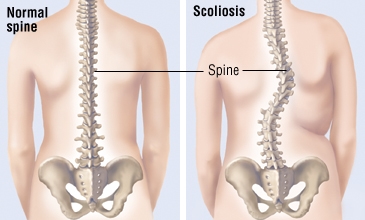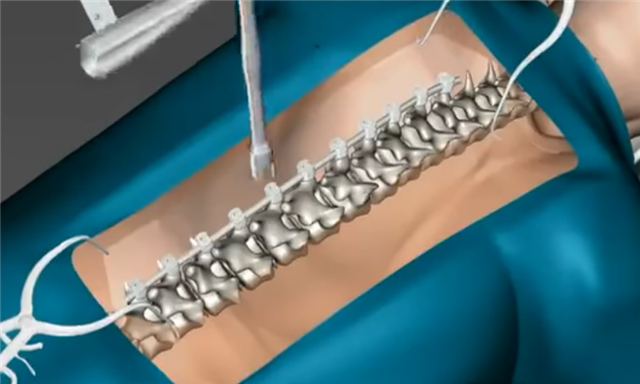Every year, around three million cases of scoliosis are diagnosed each year in the United States, with the majority of these cases being idiopathic scoliosis manifesting in children between 10 and 12 years old. (Johns Hopkins School of Medicine) According to the National Scoliosis Foundation, approximately 38,000 surgeries for scoliosis are administered every year. A specific kind of scoliosis named adolescent idiopathic scoliosis, or AIS, is “a fancy term for an extreme curvature of the spine in children that has no known source,” says Alexander Singh, CEO of Minimally Invasive Spinal Technology, LLC.
 Minimally Invasive Spinal Technology, LLC, or MIST for short, is aiming to significantly improve treatment for scoliosis patients, specifically children afflicted with AIS. Alexander first became familiar with the complex and tedious AIS surgery procedure when a family member of his was diagnosed with scoliosis. “Last summer, my younger brother had surgery for AIS, and after he had that surgery, I reviewed his experiences and thought to myself, ‘There’s definitely a better way to do this -- a way to not create as much pain, and to make the lives of patients a lot easier.'”
Minimally Invasive Spinal Technology, LLC, or MIST for short, is aiming to significantly improve treatment for scoliosis patients, specifically children afflicted with AIS. Alexander first became familiar with the complex and tedious AIS surgery procedure when a family member of his was diagnosed with scoliosis. “Last summer, my younger brother had surgery for AIS, and after he had that surgery, I reviewed his experiences and thought to myself, ‘There’s definitely a better way to do this -- a way to not create as much pain, and to make the lives of patients a lot easier.'”
After deciding to develop a new method of treatment for scoliosis, Alexander recruited his long-time friend Rohit Rustagi to help him start MIST. "I sent out an email through the engineering school to find other people that were interested in working with me on AIS,” says Alexander, “and Rohit was one of those people.”
Rohit is COO of MIST, and despite not having any direct connection with scoliosis like Alexander does, he is equally motivated to work on the problem. “I don’t have a family connection to scoliosis, but from the people we’ve talked to and the doctors we’ve spoken with, there’s a clear problem here,” Rohit says. “These people who have scoliosis right now have two options: they can either live their life in pain and have all the other debilitating effects of scoliosis, or they can have a straight back but might never be able to play sports again or really move their spine much at all. That’s a very black and white choice, and there’s not really a good solution yet.”
The research on scoliosis backs up Rohit’s statement. According to Harvard Medical School, if scoliosis goes untreated, it can result in complications such as back pain, constant fatigue, breathing problems, or even permanent deformities of the body. Potentially even more worrying, however, is the surgical procedure for treating severe scoliosis. As explained by the Scoliosis Research Society and shown in this short example animation, “surgical treatment [for scoliosis] today utilizes metal implants which are attached to the spine, and then connected to a single rod or two rods. Implants are used to correct the spine and hold the spine in the corrected position.”
 “The super invasive surgical process involves making a huge incision down the back, putting screws into every vertebra in the spine and then implantation of titanium rods,” says Alexander, “and I think everyone can imagine how painful and complicated that must be for both the patient and the physician.”
“The super invasive surgical process involves making a huge incision down the back, putting screws into every vertebra in the spine and then implantation of titanium rods,” says Alexander, “and I think everyone can imagine how painful and complicated that must be for both the patient and the physician.”
***
Right now, Rohit and Alexander are working in the iLab, continuing to talk with medical professionals with spine or scoliosis experience, starting material testing, and beginning to navigate the FDA approval process. On their experience so far, Alexander responded that for MIST, “the biggest way the iLab is helping us is through the mentor program, especially to connect us with people out there who are really helping us to develop our technology and make our way through the FDA approval process.”
Alexander and Rohit also had some advice to share with those who want to follow in their footsteps. “Some advice I would give is to keep track of all the contacts you have and constantly following up with them,” Rohit says. “I heard a pretty good saying about this: ‘Instead of following up, follow through.’ Just keep in touch constantly, do people favors, and keep them in the loop so that if the time comes when you need them, they’ll be there for you, and vice versa.”
Finally, on what keeps them going, Alexander said, “It’s really nice to be validated. Not only are doctors and patients that we talk to telling us that what we’re doing is great, but that reaction of, ‘Wow, you guys are trying to take on a noble cause and we really appreciate you stepping up and attempting to fix it.’ It’s rewarding to hear that from people who have decades more experience than we do.”
Perhaps the strongest motivator pushing the MIST team forward, however, is seeing scoliosis patients themselves. “Rohit and I recently went to a 5K scoliosis awareness walk, and there were a lot of scoliosis patients participating. It’s really amazing to see how happy these people can still be. Think about it: you have a curved spine, you have really bad cosmetic issues, oftentimes you need to wear a brace that’s uncomfortable, people will make fun of you, and so on. But these kids still keep on trucking, and that’s so inspiring.”
Hopefully, MIST’s future scoliosis treatment will be able to give these children a more normal childhood and a less painful future.
***
About The Team
 Alexander Singh (left) is a 3rd-year student and Rodman Scholar at the University of Virginia. He is a member of the Medical Device Design Group at UVA and an undergraduate research assistant at the Center for Applied Biomechanics. He has also presented his work on Achilles Tendon injuries at the 2017 Annual BMES Conference. As a Kairos Fellow, Alexander has developed extensive connections with undergraduate students across the globe.
Alexander Singh (left) is a 3rd-year student and Rodman Scholar at the University of Virginia. He is a member of the Medical Device Design Group at UVA and an undergraduate research assistant at the Center for Applied Biomechanics. He has also presented his work on Achilles Tendon injuries at the 2017 Annual BMES Conference. As a Kairos Fellow, Alexander has developed extensive connections with undergraduate students across the globe.
 Rohit Rustagi (right) is also a 3rd-year student, member of the Medical Device Design Group, and Rodman Scholar at the University of Virginia. Rohit has been part of a biomedical genetic engineering lab at UVA for more than two and a half years. In addition to this extensive scientific research, Rohit is also a leader in public health research, having been awarded over $30,000 in grants to research and improve the current state of potable water acquisition in rural Nicaragua. Additionally, Rohit founded UVA Synapse, an organization that pairs neurosurgery trauma patients with students for emotional and social support.
Rohit Rustagi (right) is also a 3rd-year student, member of the Medical Device Design Group, and Rodman Scholar at the University of Virginia. Rohit has been part of a biomedical genetic engineering lab at UVA for more than two and a half years. In addition to this extensive scientific research, Rohit is also a leader in public health research, having been awarded over $30,000 in grants to research and improve the current state of potable water acquisition in rural Nicaragua. Additionally, Rohit founded UVA Synapse, an organization that pairs neurosurgery trauma patients with students for emotional and social support.
More information about MIST and their work can be found at www.minspinaltech.com.
